Dogs
21 Dog Breeds That Resemble Bears Or Teddy Bears!
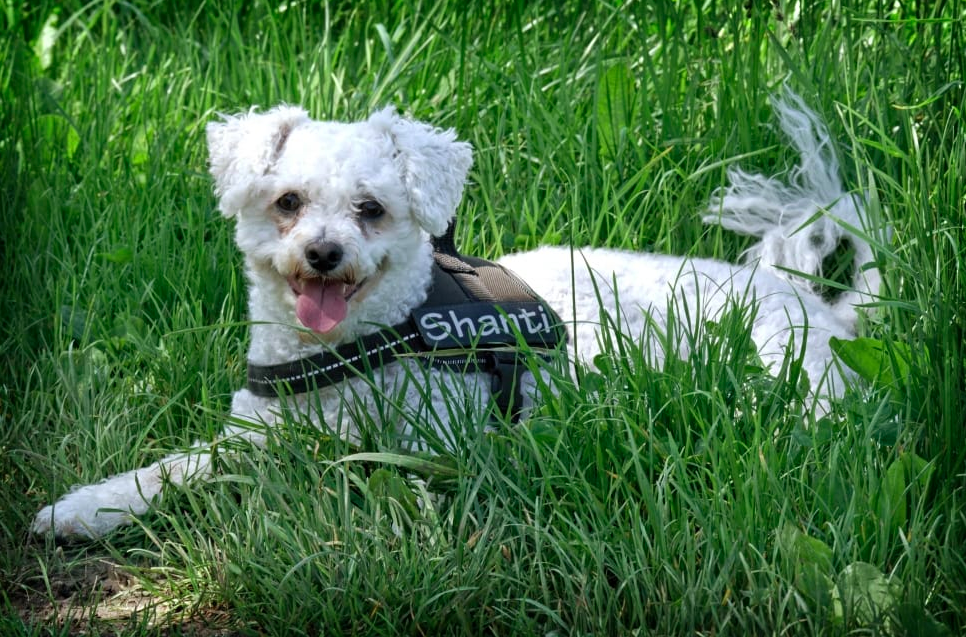
21 Dog breeds that resemble bears or teddy bears!
Have you ever dreamed of having your very own real-life teddy bear? You may even aim a little higher and want a full-sized savage beast on your hands and knees. Adopting a grizzly bear cub presents its own set of difficulties, so locating a dog that closely resembles one is the next best thing. You’ve come to the correct location, to be honest.
The complete spectrum of breeds in all shapes and sizes, all of which have those bear-like characteristics, is represented here, and we’ve included a little bit of information about each dog to help you discover the one that’s right for you.
Haircuts Can Make a Significant Difference.
For some breeds, just a small amount of grooming to achieve the actual teddy bear dog appearance is the most often requested service at my grooming store (especially among non-shedding breeds).
The Teddy Bear cut is exactly what it sounds like: it’s a cut that looks like a teddy bear. We shape the face, trim around the ears, and carve out a mane, giving your puppy the appearance of a beautiful little bear cub.
So the next time you take your dog to the groomer, inquire as to whether a teddy bear cut will be appropriate for him. Teddy Bear Dog Breeds Are Divided Into Three Sizes: Small, Medium, and Large.
1). Bichon Frise
The Bichon Frise is everything you might desire in a real-life teddy bear: cheerful, loving, and a little mischief-maker. They are fiercely clever, friendly, goofy, and cuddly creatures that are loved by all.
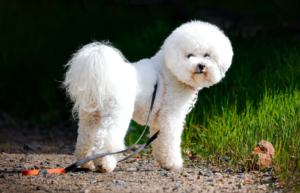
All of that silliness will have to be burned off soon, and some daily exercise will assist them in excelling and living life to the best extent possible. The Bichon is a breed that adapts well to any living situation and makes excellent apartment pets.
Keep in mind that these dogs are very sensitive to correction. They will flourish if they receive gentle teaching and are raised in a favorable atmosphere.
2). Border Terrier
The Border Terrier lives by the mantra “Work hard, play hard.” Because these dogs were originally intended to hunt foxes, they were born with instincts for running, digging, and chasing.
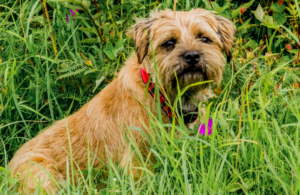
As a result, working with this breed might be a hard experience. The Border Terrier is a highly intelligent and devoted dog, but they come with a long list of requirements that not every owner is willing to meet.
They require a very busy daily lifestyle to compensate for all of their energy when hunting.
Border Terriers have enormous hearts and like being the center of attention while with their family or friends. Despite needing a tremendous deal of effort, they provide their owners with an unlimited supply of love and affection.
3). The Cockapoo
The Cockapoo is the epitome of a companion dog: affectionate, clever, and loyal to your side at all times. This is the ultimate family dog since they will never harbor any ill will against anyone or anything in the world!
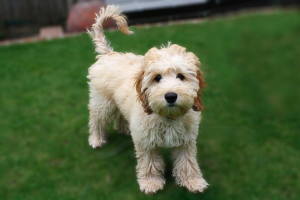
Cockapoos are pure, unconditional love to the bone, and they are known for it. As a result of their desire to please their owners, they make excellent training partners and are particularly suited to first-time owners.
While they still require frequent grooming, this breed sheds very little, is quiet, and does not drool.
4). The Lhasa Apso
This renowned breed of dog was formerly used to guard the royal palaces of Tibet, and it continues to do so with distinction to this day.
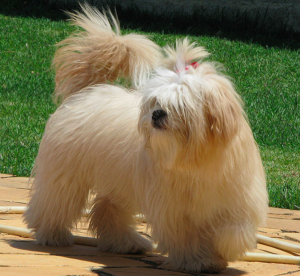
These are strong, self-sufficient canines who take their responsibility as protectors extremely seriously. So they can be quite rude to strangers while remaining strongly devoted to their own families and friends.
For this strong-willed breed, constant teaching from an authoritative figure is required before the Lhasa will listen. They are naturally protective means that they must be socialized at a young age.
5). The Pekingese
The Pekingese is a rare breed that originated in ancient China. What makes them even rarer is their coat, which can be maintained extravagantly at certain periods.
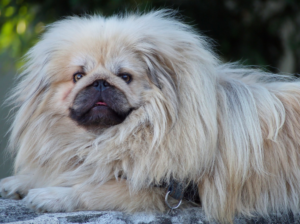
Nevertheless, with the help of a teddy bear trimmed by your groomer, this dog can be transformed into a beautiful cub.
As a result of their independent spirit, which allows them to set their own rules, the Pekingese can be extremely stubborn in training and toilet training.
In addition, they may be extremely loud and have a tendency to bark at just about everything. Because of this, the Pekingese is not an ideal dog for households with small children, other dogs, or first-time dog proprietors.
6). Pomeranian
In addition to being a sometimes overconfident troublemaker (but it’s all in good fun), the Pomeranian is also the star of their show. These Dogs can be regarded as confident, curious, and appreciative of being treated as if they were princes (or princesses).

Given their outsized personality, you’ll need to create some ground rules to ensure that they don’t feel they have complete control over the household. And they can be particularly difficult to train when it comes to toilet training and excessive barking.
These small pups make excellent companions for going on trips; they enjoy spending their days following you about and seem to genuinely appreciate new situations and situations. Keep in mind that they are heat-sensitive and require cooling downtime from time to time.
7). The Shih Tzu
In this instance, the Shih Tzu will undoubtedly benefit from displaying their trademark grooming style, known as “the teddy bear cut.” And these canines are all about strutting their stuff since they adore being the focus of everyone’s attention.
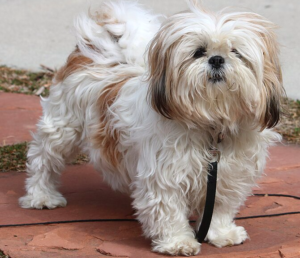
These beasts are affectionate and lively, and they would love nothing more than to spend the rest of their days with you. Shih Tzus have a natural tendency to be friendly because they were originally designed to be companion dogs.
Thus, you will not find any hunting or herding characteristics here. They can, however, be too energetic and difficult to control at times.
Some owners believe that the best way to keep their Shih Tzus happy and engaged is to adopt two of them so that they each have a companion.
8). Toy Poodle
You might not think of a poodle as the first dog that comes to mind when thinking about teddy bears, but you might be amazed at what a little grooming magic can do for them.
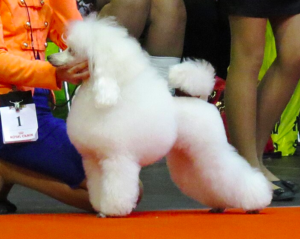
The teddy bear cut is the most requested grooming service, and it does exactly what it says on the tin. Poodle dogs are known to be one of the most intelligent dog breeds, placing them at the top of their class.
They are eager to satisfy their owners, and because they have so many brains, they are particularly ready to learn new things.
Early on, they are bursting with activity and have lots of “talking” to do. They also have a tendency to go in search of trouble by digging and running around.
They require an authoritative leader to define the norms and an outlet for the excess energy they generate regularly. They tend to become more tranquil as they mature, but they still require stimulation for their physical and mental well-being.
9). Yorkshire Terrier
Yorkies are the stars of their show, and they want to make sure that everyone is paying attention to what they’re doing. A lot of personalities are on display, and it comes with a lot of sass, which is what they are known for.
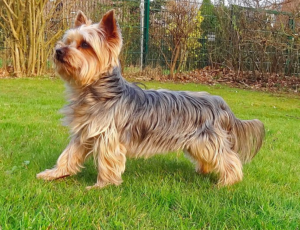
This breed was developed for the purpose of hunting rodents, and these characteristics are still extremely evident in their prey drive, which is out of this world.
Yorkies are social creatures who need friendship and demonstrate unwavering loyalty and trust for their owners. However, their owner is the only person who cares about them, and no one else is permitted to enter into that relationship at times.
These dogs can be aggressive against strangers, other pets, and even other members of the family on rare occasions. These are adorable tiny lapdogs who enjoy playing and exploring, and they are especially well-suited for singles.
As a result of their predisposition to be aggressive, these dogs are not advised for households with young children. A teddy bear trim can help your Yorkie resemble that lovely bear cub more closely, which we highly recommend.
Breeds of a Medium Size
10). Chow Chow
Chow Chows have a distinctive appearance that mimics that of a cuddly teddy bear dog, which they are. However, these dogs are considered to be anything but cuddly since they are known to have a strong sense of independence.
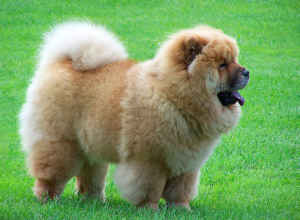
They’ll often be wary of people and other animals, and they’re known to be very protective of their young. The Chow Chow will learn to accept children and strangers if you start training and socializing him at a young age.
However, if this dog does not receive this early instruction, his patience will be severely tested. As a result, adopting an older Chow Chow is advised for older families with a history of dog ownership and training.
Chinese breeders have recently begun training Chow Chows to look like pandas, becoming a popular new trend.
11). Keeshond
The Keeshond is distinguished by its distinctive grey coat, resembling a wolf’s mane. When they’re young, they look a lot like a bear cub, with small, rounded ears and a rounded nose.

However, as they grow older, they lose some of their cub-like appearances. Spending time with his family and other loved ones is something that this dog aspires to do without fail.
Keeshonds are highly gregarious animals who cannot be left alone at any moment. That will become abundantly clear as they “Velcro” themselves to you and follow you everywhere you go.
And that thick coat needs attention as well since you’ll be taking on the role of a full-time brusher to keep the excessive amounts of shedding under control.
Keeshonds can be a mouthy breed, and even though they have the best intentions, they tend to shout and yell a lot.
12). Shiba Inu
Japan’s Shiba dogs are a unique breed with a variety of quirky characteristics and a humorous demeanor. Shibas, on the other hand, is fiercely independent, which comes with a certain element of stubbornness.
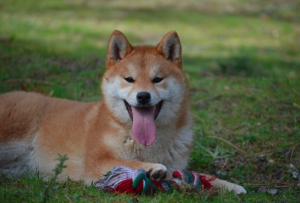
Despite the fact that they are quite bright, teaching them is a time-consuming operation that is best left to experienced owners.
These canines have a strong prey drive and a tendency to remain on the lookout all of the time. As a result, they frequently chase after small animals and bark at strangers. However, they may thrive in a family setting with the right training, socialization, and love.
Bear Dogs of a Spectacular Size
13). Akita Inu
The Akita, which was once deployed to defend royalty, has since retired from guard duties and has returned to his family.
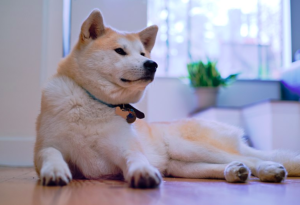
These dogs are a proud breed that has unflinching respect for their owners and loved ones, but they may also be too protective at times, especially when they are young.
Their protective instincts are still extremely strong. Akitas like conversing with one another at all hours and every day.
They use their vocal cords to make themselves known in every scenario, frequently with humorous results, somewhere in the middle of whining and barking. They tend to utilize that mouth for other things, like carrying articles or toys about with them at all times.
Because of their protective attitude and strong opinions, the Akita is difficult to teach and is not recommended for first-time dog owners. These dogs have aggressive tendencies, and it will take a lot of patience to get through them.
14). Bouvier des Flandres
The Bouvier is a robust and fearless bear, which is exactly what you’d expect from a bear of its size. Originally, they were bred for herding and farm work, and they were employed to guard and protect live animals.
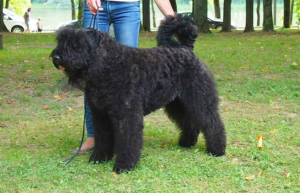
Exercise daily is definitely necessary to keep this huge guy happy. Of course, with that great height comes great confidence and a bear’s sense of belonging; they are courageous dogs who are always ready to defend the “pack” when called upon.
Owners will need to display forceful leadership in order to preserve control over who is truly in charge. Despite their “tough-guy” demeanor, they are very gentle and affectionate creatures when it comes to their family and friends.
They are excellent with youngsters but are apprehensive of strangers and other pets.
15). Caucasian Shepherd Dog
Known variously as the Ovcharka Dog or the Russian Bear, this is a large breed that can weigh more than 200 pounds at times.
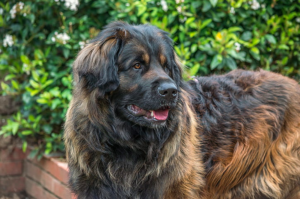
This is not surprising considering that these beasts were once utilized in the Russian military to protect livestock, and they still take their guard role very seriously.
When there is nothing to defend, these dogs will sleep for days on end and are notoriously sluggish and apathetic. On the other hand, walking and playing remain vital parts of their daily routine.
And you are correct in assuming that these are heavy-duty droolers and shedders from the look of them. To summarize, these dogs are excellent for acreages or farms, where they can roam and nap while also providing protection and receiving affection from their owners.
16). Eurasier
An unusual breed originated in Germany but is progressively rising in favor worldwide. Curious, peaceful, intellectual, and affectionate are all characteristics associated with the Eurasier.
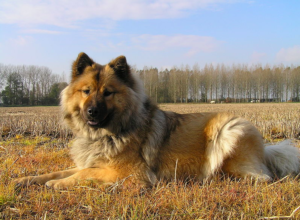
While they are rarely aggressive, they might be wary of strangers and unfamiliar canines – but early socialization can help to alleviate their shyness and apprehension.
It is not uncommon for Eurasiers to fall head over heels in love or affection with their owners, and their cheer intelligence makes them easy to train.
Not to mention that they aren’t extremely energetic, so their peaceful nature makes them a good choice for a household pet. Eurasiers, on the other hand, are big shedders; thus, that coat will require some extra attention.
17). The Great Pyrenees
Since it was first employed for herding and protection, the Great Pyrenees has continued to carry on that tradition. Although they come from a protective environment, these gentle mammals have large hearts and are capable of unconditional love.
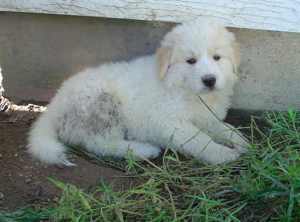
While extremely friendly, the Great Pyrenees can be wary of strangers and will feel forced to herd other dogs and little children when they are first introduced.
Their independent character makes them exceedingly tough to train, and although they hear your directives loud and clear, they will choose to disregard them.
Big barks are a trademark of these imposing figures, and they like employing them. Not to mention the fact that the shedding is out of control.
As a result of this, several unique challenges arise that most business owners find difficult to deal with. However, most of these business owners would argue that the result is well worth the effort.
18). The Newfoundland Dog
A formidable working breed for fishing boats and docks, this dog has now retired to a life of family and relaxation after a long and productive career.
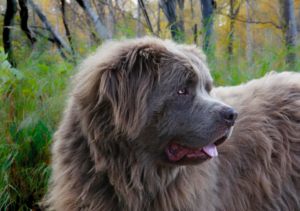
The Newfoundland are recognized for their calm attitude, but they are also famed for their bravery when an act of heroism is required.
There are numerous incredible examples of these canines rescuing children, adults, and other animals from potentially life-threatening circumstances. It should not be a surprise that they are considered to be among the most loyal and obedient dog breeds ever.
The Newfoundland is considered to be more of a family member than a canine; they naturally protect their owners’ children and exhibit tremendous loyalty and affection to those who care for them. In essence, you are adopting more than 100 pounds of love.
They are quite substantial when it comes to weight — weighing an average of 120 pounds, with males occasionally exceeding 160 pounds. And with such a thick coat comes a lot of maintenance; you’ll be brushing it every day and taking it to the groomer frequently.
19). Samoyed
The Samoyed has a beautiful white, fluffy coat that could be mistaken for a plush polar bear if you look closely. These dogs are sweet-natured and enjoy being the center of attention, and they’ll be a great addition to any household, no matter how large or small.
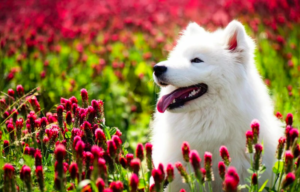
Furthermore, they are a highly intelligent breed, making training them a complete pleasure. Samoyeds, despite the fact that they are loving and intelligent, can be a handful.
These are a working breed, and they require regular runs or duties to keep their minds active and working, or they will become bored and destructive to your home and property.
And let’s not forget about its fluffy coat – Samoyed fur is a force to be reckoned with when it comes to fashion. Be prepared for an infinite quantity of shedding, brushing, and trips to the groomer.
20). St. Bernard
These are imposing canines with enormous hearts. However, be careful that they express their affection through cuddling, slobber, shedding, and not being fully conscious of their size.
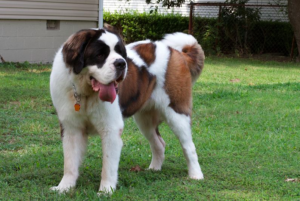
And, despite being designed for cold weather, St. Bernard’s is primarily an indoor family member. A final point to consider is that these large men may accidentally knock over items or little children in your home.
St. Bernard adoption entails adapting your lifestyle to accommodate their size (and, at times, clumsiness), which is why they are best suited for homes without children.
21). Tibetan Mastiff
If you’re seeking a bear, you’ve come to the right place. The Tibetan Mastiff, which may weigh up to 175 pounds and stand 30 inches tall, is a monstrous creature. Unsurprisingly, these Mastiffs have been utilized to protect livestock for hundreds of years.
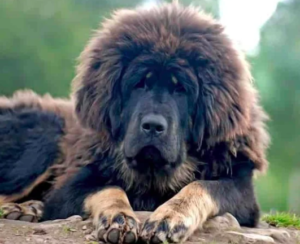
Despite its intimidating appearance, this beast has a great heart and can be extremely affectionate and cuddly with its humans. All they want to do is spend the day with their loved ones, and they’re quiet and patient in their approach.
There are certain obstacles to overcome when adopting such a large dog. Training and socialization begin at a very young age, which is absolutely necessary.
You want your mastiff to be confident in the presence of children, other pets, and strangers. However, this breed is well-known for being stubborn, and obedience isn’t usually high on their list of priorities.
We appreciate you taking the time to read!
Finally, we hope you found this article interesting? And what do you think about ‘’21 Dog breeds that resemble bears or teddy bears!?”
Please get in touch with us if you would like to contribute to this article or advertise.
And let us know if you notice something that isn’t quite right.
Dogs
Exploring the Diverse World of Dog Breeds: A Look at the Seven Main Groups + the others

Exploring the Diverse World of Dog Breeds: A Look at the Seven Main Groups + the others
Dogs are one of the most diverse species on the planet, with hundreds of different breeds that vary widely in size, shape, temperament, and behavior. To help organize this diversity, dog breeds are often grouped into categories based on their original purpose or characteristics.
These groups, recognized by kennel clubs and breed organizations worldwide, provide a framework for understanding the different types of dogs and their typical traits. Here are the main groups of dogs:
- Sporting Group: These dogs were bred for hunting game birds, both on land and in the water. They are known for their stamina, intelligence, and willingness to please. Breeds in this group include the Labrador Retriever, Golden Retriever, and English Springer Spaniel.
- Hound Group: Hounds are known for their keen sense of smell and ability to track prey. They are often used for hunting and tracking game. Breeds in this group include the Beagle, Bloodhound, and Greyhound.
- Working Group: Dogs in this group were bred for specific tasks, such as guarding property, pulling sleds, or performing water rescues. They are known for their strength, intelligence, and trainability. Breeds in this group include the Siberian Husky, Boxer, and Great Dane.
- Terrier Group: Terriers were originally bred to hunt and kill vermin. They are known for their feisty and energetic nature. Breeds in this group include the Jack Russell Terrier, Bull Terrier, and Scottish Terrier.
- Toy Group: Toy breeds are small companion dogs that were bred for their portable size and charming personalities. They are often kept as lap dogs or companions. Breeds in this group include the Chihuahua, Pomeranian, and Shih Tzu.
- Non-Sporting Group: This group is a diverse collection of breeds that don’t fit into other categories. They vary widely in size, coat type, and temperament. Breeds in this group include the Bulldog, Poodle, and Dalmatian.
- Herding Group: These dogs were bred to control the movement of other animals, such as sheep or cattle. They are known for their intelligence, agility, and strong herding instincts. Breeds in this group include the Border Collie, Australian Shepherd, and German Shepherd Dog.
Each group has its own unique characteristics and traits, but all dogs share a common bond with humans as loyal companions and working partners. Understanding these groups can help you choose a breed that fits your lifestyle and preferences.
Sporting Group
- American Water Spaniel
- Boykin Spaniel
- Chesapeake Bay Retriever
- Clumber Spaniel
- Curly-Coated Retriever
- English Setter
- Flat-Coated Retriever
- Gordon Setter
- Irish Red and White Setter
- Irish Setter
- Irish Water Spaniel
- Nova Scotia Duck Tolling Retriever
- Pointer
- Spinone Italiano
- Sussex Spaniel
- Vizsla
- Weimaraner
- Welsh Springer Spaniel
- Wirehaired Pointing Griffon
Hound Group
- Afghan Hound
- American English Coonhound
- American Foxhound
- Basenji
- Black and Tan Coonhound
- Borzoi
- Cirneco dell’Etna
- Finnish Spitz
- Grand Basset Griffon Vendéen
- Greyhound
- Harrier
- Ibizan Hound
- Norwegian Elkhound
- Otterhound
- Petit Basset Griffon Vendéen
- Pharaoh Hound
- Plott
- Portuguese Podengo
- Redbone Coonhound
- Rhodesian Ridgeback
- Saluki
- Scottish Deerhound
- Sloughi
- Treeing Walker Coonhound
- Whippet
Working Group
- Akita
- Alaskan Malamute
- Anatolian Shepherd Dog
- Bernese Mountain Dog
- Black Russian Terrier
- Boerboel
- Boxer
- Bullmastiff
- Cane Corso
- Dogo Argentino
- Dogue de Bordeaux
- Greater Swiss Mountain Dog
- Great Pyrenees
- Komondor
- Kuvasz
- Leonberger
- Mastiff
- Neapolitan Mastiff
- Newfoundland
- Rottweiler
- Samoyed
- Siberian Husky
- St. Bernard
- Tibetan Mastiff
Terrier Group
- Airedale Terrier
- American Staffordshire Terrier
- Australian Terrier
- Bedlington Terrier
- Border Terrier
- Bull Terrier
- Cairn Terrier
- Cesky Terrier
- Dandie Dinmont Terrier
- Glen of Imaal Terrier
- Irish Terrier
- Kerry Blue Terrier
- Lakeland Terrier
- Manchester Terrier
- Miniature Bull Terrier
- Miniature Schnauzer
- Norfolk Terrier
- Norwich Terrier
- Parson Russell Terrier
- Russell Terrier
- Scottish Terrier
- Sealyham Terrier
- Skye Terrier
- Smooth Fox Terrier
- Soft Coated Wheaten Terrier
- Staffordshire Bull Terrier
- Welsh Terrier
- West Highland White Terrier
- Wire Fox Terrier
Toy Group
- Affenpinscher
- Brussels Griffon
- Cavalier King Charles Spaniel
- Chihuahua
- Chinese Crested
- English Toy Spaniel
- Havanese
- Italian Greyhound
- Japanese Chin
- Maltese
- Manchester Terrier (Toy)
- Miniature Pinscher
- Papillon
- Pekingese
- Pomeranian
- Poodle (Toy)
- Pug
- Shih Tzu
- Silky Terrier
- Toy Fox Terrier
- Yorkshire Terrier
Non-Sporting Group
- American Eskimo Dog
- Bichon Frise
- Boston Terrier
- Bulldog
- Chinese Shar-Pei
- Chow Chow
- Dalmatian
- Finnish Spitz
- French Bulldog
- Keeshond
- Lhasa Apso
- Lowchen
- Norwegian Lundehund
- Poodle (Miniature)
- Schipperke
- Shiba Inu
- Tibetan Spaniel
- Tibetan Terrier
- Xoloitzcuintli
Herding Group
- Australian Cattle Dog
- Australian Shepherd
- Bearded Collie
- Belgian Malinois
- Belgian Sheepdog
- Belgian Tervuren
- Border Collie
- Bouvier des Flandres
- Briard
- Canaan Dog
- Cardigan Welsh Corgi
- Collie (Rough)
- Collie (Smooth)
- German Shepherd Dog
- Icelandic Sheepdog
- Miniature American Shepherd
- Norwegian Buhund
- Old English Sheepdog
- Pembroke Welsh Corgi
- Polish Lowland Sheepdog
- Puli
- Pyrenean Shepherd
- Shetland Sheepdog
- Spanish Water Dog
- Swedish Vallhund
Miscellaneous Class
- American Hairless Terrier
- Barbet
- Biewer Terrier
- Boerboel
- Coton de Tulear
- Czechoslovakian Vlcak
- Lagotto Romagnolo
- Mudi
- Nederlandse Kooikerhondje
- Peruvian Inca Orchid
- Portuguese Podengo
- Rat Terrier
- Russian Toy
- Sloughi
- Thai Ridgeback
- Xoloitzcuintli
Rare Breeds
- Azawakh
- Bergamasco
- Chinook
- Cirneco dell’Etna
- Dandie Dinmont Terrier
- Finnish Lapphund
- Finnish Spitz
- Grand Basset Griffon Vendéen
- Kooikerhondje
- Lagotto Romagnolo
- Lowchen
- Norwegian Lundehund
- Otterhound
- Peruvian Inca Orchid
- Schipperke
- Sealyham Terrier
- Skye Terrier
- Sussex Spaniel
- Swedish Vallhund
- Tibetan Mastiff
Designer and Hybrid Breeds
- Labradoodle (Labrador Retriever + Poodle)
- Goldendoodle (Golden Retriever + Poodle)
- Cockapoo (Cocker Spaniel + Poodle)
- Pomsky (Pomeranian + Husky)
- Maltipoo (Maltese + Poodle)
- Cavapoo (Cavalier King Charles Spaniel + Poodle)
- Yorkipoo (Yorkshire Terrier + Poodle)
- Sheepadoodle (Old English Sheepdog + Poodle)
- Bernedoodle (Bernese Mountain Dog + Poodle)
- Aussiedoodle (Australian Shepherd + Poodle)
- Shih-Poo (Shih Tzu + Poodle)
- Boxerdoodle (Boxer + Poodle)
- Schnoodle (Schnauzer + Poodle)
- Chorkie (Chihuahua + Yorkshire Terrier)
- Puggle (Pug + Beagle)
- Cockapoo (Cocker Spaniel + Poodle)
- Labradoodle (Labrador Retriever + Poodle)
- Goldendoodle (Golden Retriever + Poodle)
- Cockapoo (Cocker Spaniel + Poodle)
- Pomsky (Pomeranian + Husky)
- Maltipoo (Maltese + Poodle)
- Cavapoo (Cavalier King Charles Spaniel + Poodle)
- Yorkipoo (Yorkshire Terrier + Poodle)
- Sheepadoodle (Old English Sheepdog + Poodle)
- Bernedoodle (Bernese Mountain Dog + Poodle)
- Aussiedoodle (Australian Shepherd + Poodle)
- Shih-Poo (Shih Tzu + Poodle)
- Boxerdoodle (Boxer + Poodle)
- Schnoodle (Schnauzer + Poodle)
- Chorkie (Chihuahua + Yorkshire Terrier)
- Puggle (Pug + Beagle)
Rare and Uncommon Breeds
- Bergamasco Shepherd
- Catahoula Leopard Dog
- Chinook
- Finnish Spitz
- Glen of Imaal Terrier
- Kooikerhondje
- Lagotto Romagnolo
- Mudi
- Otterhound
- Peruvian Inca Orchid
- Portuguese Podengo
- Pyrenean Shepherd
- Russian Toy
- Saluki
- Sloughi
- Swedish Vallhund
- Tibetan Mastiff
- Toy Fox Terrier
- Xoloitzcuintli
Conclusion
In conclusion, the world of dogs is incredibly diverse, with hundreds of breeds that vary widely in size, shape, temperament, and behavior. To help categorize this diversity, dog breeds are grouped into categories based on their original purpose or characteristics.
These groups, such as the Sporting Group, Hound Group, Working Group, Terrier Group, Toy Group, Non-Sporting Group, and Herding Group, provide a framework for understanding the different types of dogs and their typical traits.
Each group has its own unique characteristics and traits, but all dogs share a common bond with humans as loyal companions and working partners. Whether you’re looking for a hunting companion, a family pet, a working dog, or a lap dog, there’s a breed out there for everyone.
Understanding these groups can help you choose a breed that fits your lifestyle and preferences, ensuring a happy and fulfilling relationship between you and your canine companion.
Frequently Asked Questions (FAQs)
What are some breeds in the Sporting Group, and what are their typical characteristics?
Some breeds in the Sporting Group include the Labrador Retriever, Golden Retriever, and English Springer Spaniel. These breeds are known for their high energy levels, intelligence, and friendly nature. They are often used for hunting and retrieving game.
Which breeds are typically found in the Hound Group, and what sets them apart from other groups?
The Hound Group includes breeds such as the Beagle, Bloodhound, and Greyhound. Hounds are known for their keen sense of smell and ability to track prey. They are often used for hunting and tracking game.
What are some examples of breeds in the Working Group, and what are their common characteristics?
Breeds in the Working Group include the Siberian Husky, Boxer, and Great Dane. These dogs were bred for specific tasks, such as guarding property or pulling sleds. They are known for their strength, intelligence, and trainability.
Can you name a few breeds from the Terrier Group, and what makes them unique?
Terriers, such as the Jack Russell Terrier, Bull Terrier, and Scottish Terrier, were originally bred to hunt and kill vermin. They are known for their feisty nature and high energy levels.
What are some breeds in the Toy Group, and what role do they typically play in households?
The Toy Group includes breeds like the Chihuahua, Pomeranian, and Shih Tzu. These breeds are small in size and are often kept as lap dogs or companions. They are known for their portable size and charming personalities.
We appreciate you for taking the time to read this article!
Finally, we hope you found this article interesting? And what do you think about ”Exploring the Diverse World of Dog Breeds: A Look at the Seven Main Groups!?”
Please feel free to share or inform your friends about this article and this site, thanks!
And let us know if you observe something that isn’t quite right.
Dogs
Comprehensive List of Essential Whelping Kit Items

Comprehensive List of Essential Whelping Kit Items
If you’re just making your start as a dog breeder, you’ve likely got a lot of things on your mind. Finding a suitable mate for your dog, getting them tested—there’s a lot of mental and physical effort that goes into breeding responsibly. One way to make things easier for yourself is assembling your whelping kit early. A whelping kit contains all the necessary items to assist a mother dog during labour and ensure the safe delivery of her puppies.
For both experienced breeders and first-time pet owners, assembling a comprehensive whelping kit can make a significant difference in managing the birthing process. Having everything on-hand is a good idea, as you don’t want to suddenly be stuck without essential items in the midst of delivery.
Comprehensive List of Essential Whelping Kit Items
-
Whelping Box
The first and most crucial item is the whelping box. This is where the mother dog will give birth and care for her puppies during their first weeks of life. It should be spacious enough for the mother to move comfortably but with walls high enough to safely contain the newborn puppies.
-
Clean Towels and Blankets
You’ll need several clean towels to help dry puppies immediately after birth, which stimulates them to breathe and keeps them warm. Soft blankets can be used to line the whelping box for additional comfort.
-
Heating Pad or Heat Lamp
Maintaining a warm environment is essential, especially for newborn puppies who cannot regulate their body temperature. A heating pad or a heat lamp can provide the necessary warmth, but make sure it’s set up to avoid direct contact with the puppies and mother.
-
Digital Thermometer
To monitor the mother’s temperature leading up to labour, which can indicate when birth is imminent. A drop in body temperature is a common sign of labour starting within 24 hours.
-
Disposable Gloves
These are essential for hygiene. Wearing gloves during the delivery helps prevent the spread of infection and allows you to assist with the birth if necessary without introducing contaminants. You also don’t want to be touching anything else with dirty hands, so you may need to use multiple pairs of gloves if you have to operate your phone or move around any other items. Thankfully, a box of gloves is cheap and easy to come by.
-
Antiseptic Solution and Hand Sanitizer
Keeping your hands and the environment clean is crucial. An antiseptic solution can be used for cleaning any instruments or areas around the whelping box, while hand sanitizer should be used before and after assisting with the delivery.
-
Sterile Scissors and Dental Floss
In some cases, you may need to cut the umbilical cords. Sterile scissors are necessary for this task, and unwaxed dental floss can be used to tie off the cords before cutting to prevent bleeding.
-
Aspiration Bulb or Decongestant Syringe
To clear the puppies’ airways of mucus or fluids immediately after birth. It’s crucial for helping puppies who aren’t breathing well on their own initially.
-
Iodine Solution
After cutting the umbilical cord, applying iodine to the end helps prevent infection in the newborn puppy.
-
Puppy Feeding Kit
Includes bottles and appropriate puppy formula in case the mother is unable to nurse her puppies immediately or if there are rejected or weak puppies that need supplementary feeding.
Preparation and Storage Instructions
Organising the Kit
Arrange your whelping kit in order of likely usage. Items needed first, like gloves and towels, should be at the top or in the most accessible part of your storage container.
Storage
Keep the whelping kit in a clean, dry place that’s easily accessible during the whelping process. A portable, waterproof container with compartments can be ideal for quick access and organisation. It’s best to keep the kit in the same room where your dog will be staying, just so you don’t have to go looking for your kit once the time comes.
Preparation
Check and restock your kit well before the expected birthing date. Make sure all consumables are within their expiration date and that reusable items are clean and functional.
Troubleshooting Tips for Common Whelping Challenges
During the birthing process, several issues might arise that require immediate attention. Here are some troubleshooting tips for the most common challenges:
Stuck Puppy
If a puppy seems stuck, first ensure the mother is comfortable and not stressed. Wearing your disposable gloves, you can gently assist by providing mild traction on the puppy with a clean towel. If the puppy does not come free with gentle assistance, call your veterinarian immediately.
Weak Contractions
If the mother dog’s contractions seem weak and she’s having trouble delivering the puppies, a warm, sugar-water solution can help boost her energy. If there’s no improvement, it’s critical to contact your veterinarian, as she may need medication to strengthen contractions or even a caesarean section.
Non-responsive Puppy
If a puppy is not breathing or is too weak to nurse, stay calm. Use the decongestant syringe to clear its airways gently. Rubbing the puppy briskly with a towel can also stimulate breathing. If these methods don’t work, performing a safe puppy CPR and rushing the puppy to a vet is your next step.
Extra Useful Items
While the essentials will cover most situations, having a few additional items on hand can be beneficial:
- Nutritional Supplements for the Mother: Providing the mother with high-energy supplements or a high-calorie diet a few weeks before and after birth can help maintain her strength and improve milk production.
- Puppy Scale: To monitor the puppies’ weight daily, ensuring they are gaining weight and developing healthily.
- Record Keeping Materials: Keeping detailed records of each puppy’s birth time, weight at birth, and daily progress can be crucial, especially in large litters.
Conclusion
Preparing a comprehensive whelping kit and knowing how to use each item effectively can make the whelping easier not only on you, but also on your dog. The peace of mind that comes with knowing that you’re equipped with the right tools can be invaluable.
Remember, while a well-stocked whelping kit is crucial, nothing replaces the expertise of a qualified veterinarian during emergencies. Always have your vet’s number handy, and don’t hesitate to call if the situation becomes too difficult.
FAQs: Comprehensive List of Essential Whelping Kit Items
What is a whelping kit and why is it important?
A whelping kit is a collection of essential items needed to assist a dog during labor and the first few weeks of her puppies’ lives. It is crucial because it helps ensure the health and safety of both the mother and her puppies by providing the necessary tools and supplies to manage the birthing process and immediate postpartum care.
What are the most essential items to include in a whelping kit?
Key items to include in a whelping kit are:
- Whelping box: A clean, safe space for the mother to give birth.
- Clean towels: For drying the puppies and keeping the whelping area clean.
- Disposable gloves: To maintain hygiene during the birthing process.
- Scissors and umbilical clamps: For cutting and securing the umbilical cord.
- Bulb syringe: To clear mucus from the puppies’ airways.
How can I prepare for potential emergencies during whelping?
To prepare for emergencies, you should have:
- Contact information for a vet: In case of complications during birth.
- Puppy milk replacer and bottles: If the mother is unable to nurse.
- Heat source: Such as a heating pad or heat lamp to keep the puppies warm.
- Antiseptic solution: For cleaning any wounds or the umbilical cord area.
- Emergency medical supplies: Including a thermometer, stethoscope, and sterile gauze pads.
What items are necessary for post-whelping care?
For post-whelping care, you will need:
- Puppy scales: To monitor the puppies’ weight gain.
- Puppy ID collars: To identify and keep track of each puppy.
- High-quality puppy food: For when they start weaning.
- Cleaning supplies: Such as disinfectant and puppy pads to maintain a clean environment.
- Record-keeping materials: To document each puppy’s health and progress.
How often should I check on the puppies and mother after birth?
After birth, it is important to check on the puppies and mother frequently:
- First 24 hours: Monitor closely for signs of distress or complications.
- First week: Check every few hours to ensure the puppies are nursing well and gaining weight.
- After the first week: Regular checks multiple times a day to ensure continued health and proper development.
- Ongoing: Maintain a routine of daily health checks and keep the whelping area clean and comfortable.
We appreciate you for taking the time to read this article!
Finally, we hope you found this article interesting? And what do you think about ”Comprehensive List of Essential Whelping Kit Items!?”
Please feel free to share or inform your friends about this article and this site, thanks!
And let us know if you observe something that isn’t quite right.
Dogs
Understanding and Addressing Separation Anxiety in Dogs

Understanding and Addressing Separation Anxiety in Dogs
What is Separation Anxiety?
Separation anxiety is a common behavioral issue in dogs characterized by distress or anxiety when they are separated from their owners or left alone. This condition can manifest in various ways, including excessive barking, destructive behavior, pacing, panting, or even attempts to escape.
Causes of Separation Anxiety
Several factors can contribute to the development of separation anxiety in dogs, including:
- Past Trauma: Dogs that have experienced abandonment, neglect, or traumatic events in the past may be more prone to separation anxiety.
- Change in Routine: Changes in the dog’s routine or environment, such as moving to a new home or the absence of a family member, can trigger separation anxiety.
- Lack of Socialization: Dogs that have not been properly socialized or have not learned to cope with being alone may develop separation anxiety.
- Overdependence on the Owner: Dogs that are overly dependent on their owners for companionship and reassurance may struggle to cope with being alone.
Signs of Separation Anxiety
Recognizing the signs of separation anxiety is crucial for early intervention. Common signs include:
- Excessive barking or howling when left alone
- Destructive behavior, such as chewing furniture or scratching doors
- Pacing, restlessness, or excessive panting
- Urination or defecation inside the house, even if the dog is house-trained
- Attempts to escape or self-injury when confined
Tips for Helping Dogs Cope with Separation Anxiety
- Gradual Desensitization: Gradually acclimate your dog to being alone by leaving for short periods and gradually increasing the duration over time. Use positive reinforcement techniques, such as treats or toys, to create positive associations with alone time.
- Provide Enrichment: Keep your dog mentally and physically stimulated by providing interactive toys, puzzle feeders, or engaging in regular exercise. This can help alleviate boredom and anxiety.
- Create a Safe Space: Designate a comfortable and secure space for your dog to retreat to when you’re not home. This could be a crate, a cozy corner with their bed, or a room with their favorite toys.
- Establish a Routine: Stick to a consistent daily routine to provide structure and predictability for your dog. This can help reduce anxiety and create a sense of security.
- Seek Professional Help: If your dog’s separation anxiety persists despite your efforts, consider seeking guidance from a veterinarian or a certified animal behaviorist. They can provide personalized advice and assistance tailored to your dog’s specific needs.
Conclusion
Separation anxiety can be a challenging issue for both dogs and their owners, but with patience, understanding, and proactive intervention, it is possible to help your dog overcome their anxiety and lead a happier, more balanced life.
By recognizing the signs of separation anxiety, implementing positive reinforcement techniques, and seeking professional guidance when needed, you can support your dog in coping with being alone and strengthen your bond in the process.
FAQs (Frequently Asked Questions)
Can separation anxiety in dogs be cured?
While separation anxiety in dogs can be managed and improved with proper training and intervention, it may not be entirely cured in all cases. However, with patience, consistency, and appropriate support, many dogs can learn to cope better with being alone.
How long does it take to train a dog with separation anxiety?
The time it takes to train a dog with separation anxiety can vary depending on the severity of the anxiety, the dog’s temperament, and the effectiveness of the training methods used. Some dogs may show improvement within a few weeks, while others may require months of consistent training and behavior modification.
Are there medications available to treat separation anxiety in dogs?
In some cases, veterinarians may prescribe medications, such as anti-anxiety medications or antidepressants, to help manage severe cases of separation anxiety in dogs. These medications are typically used in conjunction with behavior modification techniques and should only be prescribed under the guidance of a veterinarian.
Can hiring a pet sitter or dog walker help with separation anxiety?
Hiring a pet sitter or dog walker can be beneficial for dogs with separation anxiety as it provides them with companionship and breaks up their time alone. However, it’s essential to ensure that the pet sitter or dog walker is experienced in handling dogs with separation anxiety and follows any specific instructions or routines provided by the owner.
Can older dogs develop separation anxiety?
Yes, older dogs can develop separation anxiety, particularly if they experience changes in their environment or routine, such as the loss of a companion or a change in living arrangements. It’s essential to monitor older dogs for signs of anxiety and provide appropriate support and intervention when needed.
-

 Pet Care2 years ago
Pet Care2 years agoThe Best Dog Collars For 2022
-

 Dogs2 years ago
Dogs2 years agoBichon Frise: The Happy, Playful, and Cuddly Companion
-

 Trending Pet Stories1 year ago
Trending Pet Stories1 year ago2023 ‘World’s Ugliest Dog’ Winner: Scooter’s Tale of Resilience
-

 Animals2 years ago
Animals2 years agoAre There Animals Having Down Syndrome?
-

 Pets2 years ago
Pets2 years agoThe Fascinating World Of The Red Chameleon
-

 Dogs2 years ago
Dogs2 years agoTop 10 Most Popular Dog Breeds According To AKC.
-

 Dogs2 years ago
Dogs2 years agoEskimo Dogs from Canada – What Are They? – Find Out!
-
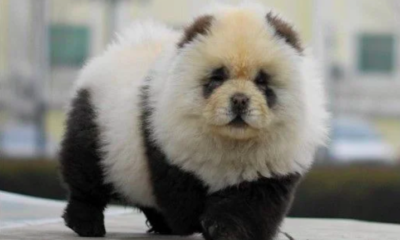
 Dogs2 years ago
Dogs2 years agoChow Chow Panda Dogs Breed, What Kind Of Dogs Are Panda Dogs? Check Them Out!














